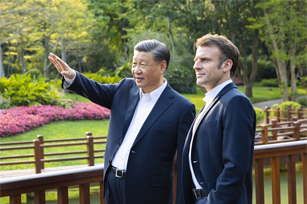Robotics and AI revitalizing traditional ceramics industry
Ceramic businesses in Chaozhou are riding high on automation and innovation, giving the traditional sector a new lease on life.
In a large plant of Guangdong Haoming Ceramic Technology, rows of industrial robots work on the production line.
The household porcelain manufacturer is an export powerhouse, with 80 percent of its annual output shipped abroad on average, according to Chen Maolin, its deputy general manager. Except for its packaging and quality inspection, Haoming has realized automation across 60-70 percent of its manufacturing, Chen said.
That enabled a threefold increase in production efficiency and reduced its labor cost by roughly 30 percent, he noted. He added that it also helps to address a shortage of skilled workers and ensures product standardization.
"We are integrating artificial intelligence and 5G technologies into our production," Chen said.
Starting cooperation with China Mobile, a major communications operator, at the end of 2019, Haoming has installed an intelligent monitoring system with a large display panel, providing real-time information on its production lines.
"It came right in time, especially considering the restrictions on international travel amid the pandemic," Chen said. "The online system provides overseas customers with easy access to learn about our progress in fulfilling their orders and gain a better understanding of our strengths in production."
On another front, ceramic bathroom ware is benefiting from information technology. Guangdong-headquartered property developer Country Garden entered this segment, investing heavily in a large project in Chaozhou last year.
Its goal is to build a 67-hectare industrial park in 2027, with a planned annual output of 5 million intelligent toilets and washbasins by then, according to Lin Chifeng, who heads the bathroom ware business unit of Country Garden.
Behind such an ambitious goal is the widespread automation of operations.
At the first phase of the project, "automated equipment has been used across our 17 major production procedures, which enables our labor efficiency to become four times that of a conventional business", Lin said.
"We are exploring a new path of upgrading the traditional industry, aimed at setting a benchmark in the sector."
In the slip casting step, one of the toughest production procedures, the company invested more than 300 million yuan ($46.36 million) to replace human workers with machinery. It has also spent some 6 million yuan installing an automatic dustproof system for the health of its workers, Lin said.
Automated equipment and information technology have enabled the company to shorten its manufacturing processes to four days, much shorter than the industry's average of around 12 days, he said, adding they also help to improve management efficiency, slash the inventory of semi-products and create a clean production environment.
In addition to upgrading traditional businesses, high-tech companies can be built on ceramics. Chaozhou Three-Circle Group, known as CCTC, specializes in providing electronic ceramic components, including resistors, rods and multilayered chip capacitors. It is at the forefront globally in terms of market share of its signature products.
Electronic ceramics and new energy are the current focus of the company's research and development, said Feng Xiaopeng, an executive at the company. CCTC owns more than 190 patents, including over 90 granted abroad.
The city government encourages local businesses to embrace digitalization, and innovate in technology, new materials and equipment. Last year saw 250 ceramics businesses above designated size in Chaozhou upgraded with intelligent technologies.
As a traditional manufacturing, sales and export hub, the city generated 50 billion yuan in its ceramics industrial output value in 2020, government data show.
Chaozhou exported ceramic products worth 4.83 billion yuan during the first eight months of this year, up 38.3 percent year-on-year. They have expanded their markets from traditional destinations in the United States and Europe to more countries and regions involved in the Belt and Road Initiative.



 Print
Print Mail
Mail

